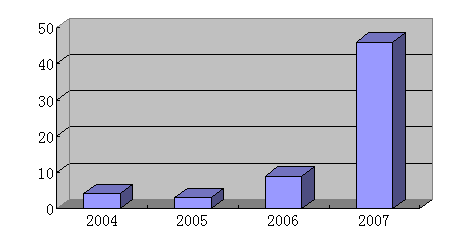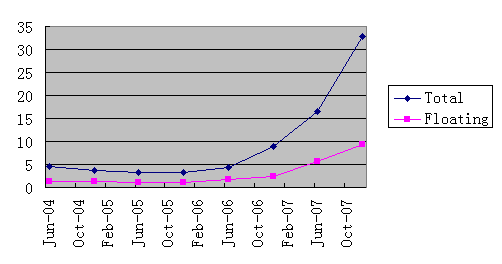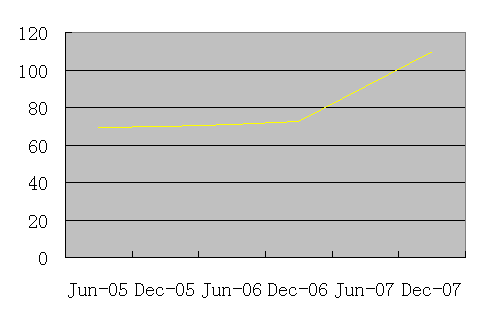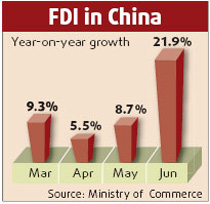A slight drop in share prices on December 28 cleared all doubts about the last trading day for China's stock market this year. Nevertheless, when the bell rang at 3pm at stock trading halls, Chinese investors celebrated the perfect close to a spectacular year for the market, and set expectations high for a promising new year - the year of 2008.
The following is a brief summarization of the remarkable achievements of the world's fourth-largest stock market, whose market value hit 32.9 trillion yuan as of December 27.
1. Market scale expansion
a. Indices
The Shanghai Composite Index, tracking the bigger bourse of China's two stock exchanges, started from 2,675 at the end of last year and closed at 5,261 on December 28, a 97 percent growth, driven by enthusiastic investment from individual and institutional investors from home and abroad. On October 16, it hit 6,124 during the trading session and closed at 6,092, as the highest level it has touched and closed in the history of China's stock market (See Chart 1).
Chart 1: Shanghai Composite Index Dynamics 2007
The Shenzhen Component Index, tracking the smaller Shenzhen exchange, rose 1.6 times higher this year. It closed at 19,531, the highest for the day and this year on October 31.
The CSI300 Index, tracking the two bourses' 300 best stocks, moved from 2,041 points last year to 5,338 as of today, an increase of 1.6 times. It reached its highest of 5,885 on October 16 and closed at record high of 5,887.
b. Trade volume
Trading in the stock market was active this year as stocks totaling 45.9 trillion yuan changed hands, compared with 9 trillion yuan last year (See Chart 2).
Chart 2: Transaction value (unit: trillion yuan)
c. Market value
As of December 27, 1,523 companies were listed on the two stock exchanges which issued a total of 1,990 securities to the market. Total market value of all securities in the market was 32.9 trillion yuan, a growth of 2.69 times from last year's 8.9 trillion yuan (See Chart 3). The value of currently tradable floating shares stood at 9.3 trillion yuan as of yesterday, up 2.72 times over the end of 2006.
Chart 3: Market value (unit: trillion yuan)
2. Market participants
a. Listed companies
China's A-share markets raised a total 447 billion yuan from initial public offerings (IPOs) this year, topping the world in terms of the amount raised. By the end of last week, Chinese stock markets witnessed a total of 120 IPOs this year, with 409.7 billion yuan raised in Shanghai and 37.3 billion yuan in Shenzhen.
By the end of November, Chinese companies raised a total 734.4 billion yuan by IPOs and additional share placements, 68 percent more than the same period last year (See Chart 4).
Chart 4: Fund raised in China's stock market (unit: billion yuan)
The high-flying performance of the stock market attracted more companies to come to list or return from overseas markets to the home bourses, especially high-quality large-cap blue chips.
Of them, 12 stocks raised more than 10 billion yuan from their IPOs. They were: China Pacific Insurance, China Shipping Container Lines, China Railway, PetroChina, China Shenhua Energy, China Construction Bank, Bank of Beijing, China COSCO, Bank of Communications, China Citic Bank, Ping An Insurance, and Industrial Bank.
Of the total 447 billion yuan raised from IPOs, the 12 enterprises raised a combined 382.89 billion yuan, or 85 percent.
b. Investors
As of December 26, there were 138 million individual stock accounts and 510,000 institutional investment accounts in China, according to the China Securities Depository and Clearing Corp. This year alone, 59 million retail accounts and 113,000 institutional accounts were opened.
The constant price growth in renminbi-denominated A shares brought more individual investors to the market, a significant 34-percentg rowth from the previous year. Of the total 109 million existing individual A-share accounts, 37 million were opened this year (See Chart 5).
Chart 5: Individual A-share investment accounts (unit: million)
Thanks to the nation's opening to overseas investors through the qualified foreign institutional investor program and support for home and abroad corporate investors, the number of institutional investors grew 28 percent this year. The 112,500 new institutional accounts consist of 104,300 A-share, 2,300 B-share and 5,900 mutual fund accounts (See Chart 6).
Chart 6: New institutional accounts
(China Daily December 29, 2007)








